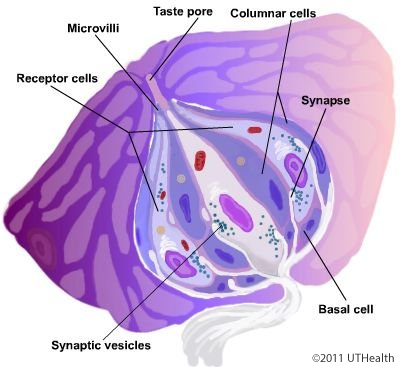Lab 7 (ƒ6) - Auditory, Vestibular, Gustatory and Olfaction Systems
The Gustatory System - Introduction
 The gustatory system is an exteroceptive system involved in the perception of chemicals (flavors) in solids and liquids that are ingested into the oral cavity. The receptor organ includes the tongue, palate, pharynx, epiglottis and esophagus. The receptor cells, taste cells, are organized into small groups, the taste buds, and are innervated by branches of three different cranial nerves. The chorda tympani branch of the facial nerve innervates the taste buds in the anterior two-thirds of the tongue. The greater superficial petrosal branch of the facial nerve innervates taste buds in the palate. The lingual branch of the glossopharyngeal nerve innervates taste buds of the posterior third of the tongue and the pharynx. The superior laryngeal branch of the vagus nerve innervates taste buds in the epiglottis and esophagus.
The gustatory system is an exteroceptive system involved in the perception of chemicals (flavors) in solids and liquids that are ingested into the oral cavity. The receptor organ includes the tongue, palate, pharynx, epiglottis and esophagus. The receptor cells, taste cells, are organized into small groups, the taste buds, and are innervated by branches of three different cranial nerves. The chorda tympani branch of the facial nerve innervates the taste buds in the anterior two-thirds of the tongue. The greater superficial petrosal branch of the facial nerve innervates taste buds in the palate. The lingual branch of the glossopharyngeal nerve innervates taste buds of the posterior third of the tongue and the pharynx. The superior laryngeal branch of the vagus nerve innervates taste buds in the epiglottis and esophagus.
The diagram is of a taste bud. Taste buds are located within the crevices of lingual papillae. The taste pore can be seen as a channel opening from the crevice of these papillae down to the pit of the taste bud. Presumably, the fluid-borne chemicals pass from the surface of the tongue down the crevice into the taste pore and onto the villi of the taste cells. Generally, the taste receptor cells cannot be differentiated from the supporting cells. Both are elongated ("banana shaped") in form, and both send villi into the cavity of the taste pore. The basal cells, as the name implies, are located in the base of the taste bud. The terminals of the 1° gustatory afferents pass between the basal cells to end upon the taste cells. The area of contact appears to be typical of a chemical synapse; i.e., vesicles cluster at the site within the receptor cell.
